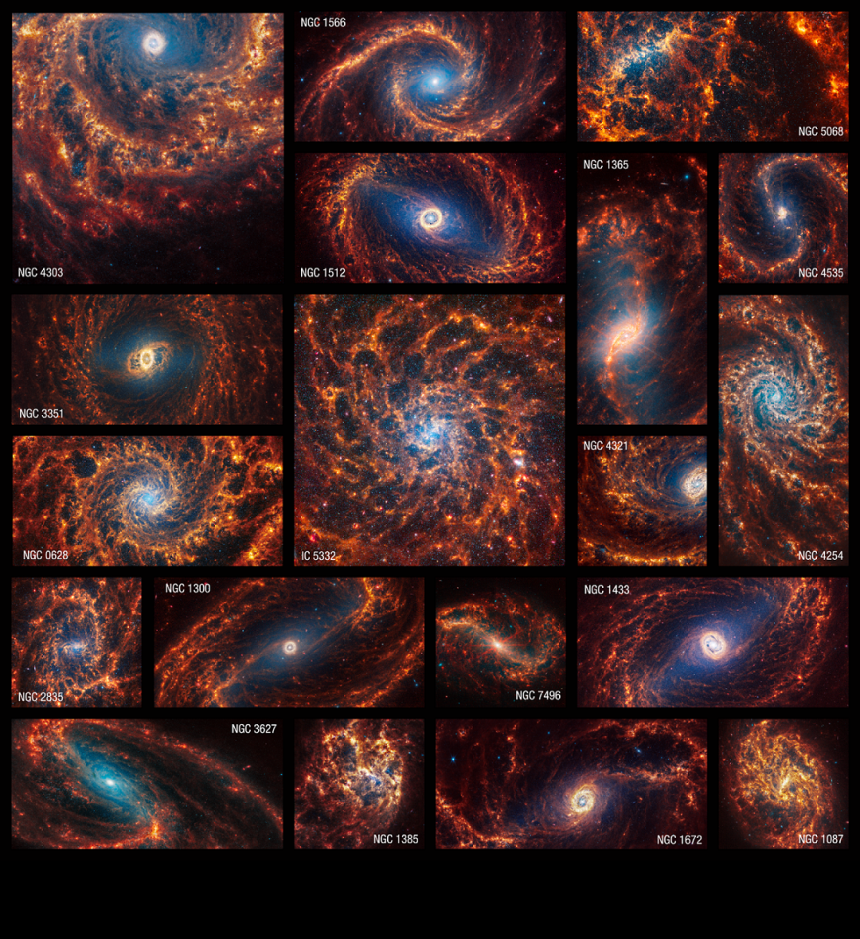NASA's James Webb Space Telescope (JWST) has publicly unveiled a collection of intricately detailed images showcasing 19 nearby spiral galaxies. This remarkable set of images is set to offer astronomers and astrophysicists worldwide several new elements to ponder and study.

The new collection of images of 19 spiral galaxies from the James Webb Space Telescope in near- and mid-infrared light. Millions of stars are captured in these images. Older stars appear blue and are clustered at the galaxies’ cores. Glowing dust around and between stars appears in shades of red and orange. Stars that have not yet fully formed and are encased in gas and dust appear bright red. Image Credit: NASA, ESA, CSA, STScI, Janice Lee (STScI), Thomas Williams (Oxford), PHANGS Team
The blue-tinted photos are of millions of stars taken by the James Webb Space Telescope’s NIRCam (Near-Infrared Camera). While some stars are dispersed along the spiral arms, star clusters are made up of groups of closely spaced stars.
Glowing dust is highlighted in the MIRI (Mid-Infrared Instrument) data from the telescope, indicating its presence around and between stars. It also highlights partially created stars, which look like brilliant red seeds at the tops of dusty peaks, still enveloped in the gas and dust that fuels their development. Large, spherical shells in the gas and dust are also visible in JWST's photos.
The data processing for the most recent set of photos took around 18 months to complete, with a team of about 10 individuals working under the direction of Dr Thomas Williams.
The amount of detail in these images is overwhelming – in a good way, also it means that we may be able to fill in more of the gaps in our knowledge about the structure and evolution of galaxies, star formation, the life-cycle of stars and so much more.
Dr Thomas Williams, Postdoctoral Researcher, Department of Physics, University of Oxford
The photos are a part of the Physics at High Angular Resolution in Nearby Galaxies (PHANGS) study, an ongoing effort with global assistance from over 150 astronomers.
The most recent pictures obtained by JWST's near- and mid-infrared spectrographs have been added to the extensive collection of data obtained by the program from the Atacama Large Millimeter/submillimeter Array, the Multi-Unit Spectroscopic Explorer of the Very Large Telescope, and NASA's Hubble Space Telescope.
This implies that in addition to near- and mid-infrared images, researchers also have access to observation data in the ultraviolet, visible, and radio light spectrum from both space and the ground.
We have been hard at work getting these data ready for science. This program is a huge volume of data, and JWST is an extremely complex observatory. Working with the data so early in JWST’s lifecycle has been a privilege and a challenge, and we have learned a lot that will improve JWST observations going forward. The images, I think, speak for themselves: this is the sharpest view we have ever had of galaxies at these wavelengths.
Dr. Thomas Williams, Postdoctoral Researcher, Department of Physics, University of Oxford
There is evidence that galaxies expand from the inside out; star creation starts at the centers of galaxies and spirals outward along their arms. A star is more likely to be younger the further it is from the galactic center.
On the other hand, some galaxy centers are covered in pink and red diffraction spikes, while the regions close to the cores that appear to be illuminated by a blue spotlight are concentrations of older stars.
There are so many avenues of research that scientists can pursue with the combined PHANGS data. The unprecedented number of stars in evidence from this latest suite of images has huge potential for cataloging and learning.
Dr. Thomas Williams, Postdoctoral Researcher, Department of Physics, University of Oxford
The PHANGS team has released the largest catalog of over 100,000-star clusters to date in addition to these photographs right away.
“The amount of analysis that can be done with these images is vastly larger than anything our team could possibly handle, and we are excited to support the community so all researchers can contribute,” states Professor Erik Rosolowsky from the University of Alberta, Canada, one of the project leads.
The European Space Agency (ESA) and the Canadian Space Agency are partners in the worldwide James Webb Space Telescope mission, which is headed by NASA.